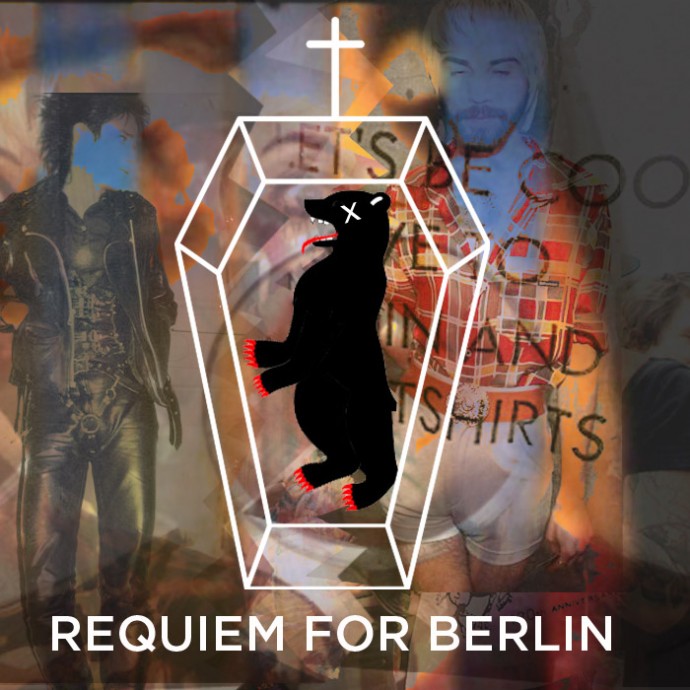Berlin has always struck me as having the characteristics of a rebellious teenager standing defiantly in a sea of mediocrity. Vagabonds, artists, punks and freaks found sanctuary on the inside of the pre-existent Berlin wall. Musician/Music Producer/Artist, Marc Chain, talks us through the extreme changes in the city as he lived through the ‘walled-island’ 80’s decade, techno and electro club 90’s and the 2000 -2007/8 phase of gentrification. He discusses what changes occurred before and after the wall came down and why the creative spirit that thrived in Berlin is dying as the bed of diversity becomes expensive, monotonous, single-minded and an increasingly infertile simulacrum of what it once was.
Berlin in the 1980’s was fucked up in a nice way most of the time. I lived in West Berlin; I was 17 and a punk. Berlin was surrounded by the wall, which created an island. Every island gives its inhabitants a certain feeling that they belong together which I could feel in the late 80s. The shared destiny immediately made every newcomer a Berliner. You were part of a big family–a family of 2 million. Perhaps due to this mentality, it was easy to talk to anyone, no matter his or her social status. But sometimes you felt trapped within the walls on the island, thus producing a schizophrenic situation. There was no real freedom for physical movement due to the border but on the other hand there was a special kind of freedom provided by the wall. I can’t say the wall was nice, but besides the rudeness of its existence it served as a protection from the square people of West Germany and the rest of the world.
The absence of any public nationalistic consciousness was also remarkable for that time. Although West Berlin belonged to West Germany, Berlin was Berlin, not Germany. This was reflected by the German identity card for Berlin, which was different in colour to the common card for West Germany. Even the word “Germany” was absent from it. When you passed the border to East Germany to get to Berlin, the East German authorities put a special stamp on your identity card, what was in fact a political provocation. On the stamp was written: “The owner of this card is a citizen with the resident Berlin.” I liked the idea of being a citizen without a state, but with an enclave that I belonged to. People also used Berlin as a vanishing point to escape from military service because draft laws did not apply to West Berlin, but were obligatory for two years at this time in West Germany.
Additionally, Berlin had a bad reputation from the point of view of square heads. Too many drugs, too much political subculture, too many radicals, too dirty, too fucked up, too poor. If you put all this together you can imagine that only certain people moved here.
The distress of the wall manifested in the subcultural street look of this time. It was common to look ‘fucked up’ or unhealthy as it symbolized resistance and a kind of stylish coldness. But it was not an attitude–the way people looked reflected the way they lived. The creative scene in general was under the influence of new wave at that time, but punk was always mixed in: do what you want and don’t ask if you are allowed to or care whether you have the education or talent to do it. A distinct situationist style in music and art developed.
As the city was poor, there were no jobs but very cheap rents. I can remember people paying 80-120 euro for a flat. Germany and also Berlin had a good welfare system, so most people did something creative, or nothing, without any capitalistic pressure. The squat house scene was important as well; they had influence on the town politics because they could build up political pressure. Near the wall there were some streets that were highly self-organized–kind of like anarchistic free zones without frequent police patrols…or garbage services.
Living in Berlin was like an endless holiday in the distress. It was also dangerous–you could easily get lost in the neon coloured rollercoaster of nightlife and the hard drug scene. Life was more existential than in any time afterwards; it was a town for outsiders, but never gave you the feeling of being an outsider.
After the wall came down, many people I knew left because a complete corrosion of the Berlin they were familiar with was taking place. During the first two years there was no social structure in the streets or in public at all. If you looked different, (gay, lesbian or punk) it was no longer secure. Drunkards from the eastern suburbs arrived to the inner city in big groups and it was advisable to take care when taking the subway or walking the streets at night. A new nationalistic and aggressive atmosphere emerged on the streets despite documentaries depicting otherwise. I hated it when Berlin later became the capital of Germany. To me, this was like an imperialistic occupation of my former island.
The 90’s were the best time and I experienced this decade of recreation from the beginning. After the wall came down new free spaces, empty places and unused buildings appeared providing endless possibilities. It was unique in the whole western world. Without this, Berlin would never have had this explosion of creativity. All this new space turned Berlin into a cosmopolitan laboratory to develop new things and avoid institutionalisation, which is always the death of any movement. It was like a big adventure playground; you could be at home and have a voyage at the same time.
I was working in a movie theatre, which was part of an alternative project in Mitte. In the building there was also a gallery, a small illegal restaurant, a video arts bar, a cocktail club bar, a cafe, a record shop as well as many artist studios and dwellings. It was a world in itself. This house project had everything you needed for a nice artist life and such projects were typical in Berlin. This movie theatre was not only where I worked but the epicenter of my social and party life.
The political statement was found more in the way people lived, in their creativity or in the ability to use public spaces, than in the manifestation of slogans as it was in the 80s. There was no need to separate the spheres of life and art anymore. Even the new squat houses in the eastern part were different to those I knew from the 80s in the western parts. The squats were more like clubs. There was more room for artists and the whole scene was more accessible to the public. It’s hard to imagine that there were nearly 150 squats in the eastern area at the beginning of the 90’s. This was an impressive symbol of the motivation and the freedom to live a self-determined life independent from any social pressure.
The attitude of the people was very do-it-yourself. When you want to do something you did it with whatever possibilities available. Buying something finished was boring. When you wanted to do something creative it was easy to find people, places and help; supporting others was the social currency. As in the 80’s, it was still uncool to have success. The indifference towards success made it usual and possible to meet and talk to a lot of famous actors or musicians from all over the world in nightlife because there was no V.I.P. scene and no V.I.P. attitude was possible. Nightlife was a constant flow of amusement mostly undisrupted by individual days and events.
Many times during my night ride, I would be told about a new illegal place. I would need to climb over a wall, go down some stairs into a cellar of an empty building and suddenly I’d find myself in a big room with hundreds of people. Every night had the potential to surprise you, like a curtain going up at a theatre. The club interiors were different from today. One reason is because neither the police, town authorities or neighbourhoods paid attention to what was going on. The club founders’ lack of resources was compensated with either lots of creativity or hardness. Some clubs were very rude or dark and you couldn’t see who was in front of you and condensed water would drip from the ceiling. Others were fancy; a club could have a bonfire in the middle of the room or flexible elements constructed in the room like tunnels so it looked different inside every time. You could sit in a swing above a dancing crowd whereas in other places you could feel like a resident in a psychiatry unit or an actor on the set of Barbarella. The ‘Private Club’ concept was particularly special. People would turn their rented apartments into clubs once or twice a week. In some apartments there were fixed bars, stages and toilet systems. You would need to know which buzzer to push at the main door to get in. The whole setting was absurd.
The Berlin music scene was most interesting during the 90’s due to the clubs having individual styles and attitudes. Electronic music seemed very innovative during this time. It ranged from very hardcore to breakbeats over trippy sounds. Lots of new labels were founded sometimes by the clubs themselves but within all of its diversity, Berlin possessed it’s special electronic sound. This sound has been lost to a dictatorship of providing a pleasant party sound for the electronic music scene and in the band scene, a frozen retro culture.
You needed little money to have fun. No one wished to take advantage of you, and a separation between party people, club owners, and artists was non-existent, there was just one family. Nowadays you feel more like a convertible customer in most clubs and not part of the whole any longer. If I should describe the atmosphere of the 90’s in one word, I would say there was an ‘airiness’ all over as opposed to the negative pressure existing today.
During this period people expressed their individuality through their appearance and not through the expression of the will to be part of a certain contemporary movement. Today there is fashion where there used to be individuality. Also, lots of new people arrived from all over the world. I must say it became too easy to criticize people who are against all the mass tourists with the argument that they aren’t accepting the new internationality of Berlin. Internationality was never something new. There were already the same large drunken crowds in the street during the 90’s as there are now in some tourist areas in Kreuzberg.
One hotspot for big crowds apart from Kollwitzplatz was the Oranienburgerstrasse in Mitte where, during the summer, there was a street party nearly every night. Hundreds of people from all over the world sat on the street, no tram could pass, everyone was drunk, bands played, all over the place was music, screaming and laughing. It was very anarchistic. But the people were different to the current atypical mass tourists and party visitors, because they were less stupid consumers of Berlin, and more creative participants who were interested in what Berlin offers in terms of art, music and club life.
“Zombiefication” works well to describe Berlin’s overall development these latest years. Expression and characteristics of Berlin are just a recycled symbol to sell, to earn money or to create a social value of being “in” and “Berlin”. Berlin is more and more an image without living content. It’s no wonder that the official town slogan is now “Be Berlin” instead of the possible “you are Berlin”.
The zombification of Berlin is nowhere better detectable than at the Fashion Week. Last Fashion Week the opening party had a ‘punk’ dress code. The party was held in a building which looked like a squat inside. The past is now a reproduction, punk is a dress code for a carnival, and squats are just an artificial ‘Disney World’ backdrop. Baudrillard would call this a “hyper reality”. People celebrate that they have the opportunity to have fun, while more and more people are excluded. You can see this especially in the fact that social status and money is more reflected in behaviour, look, clothes and how people are treated in Berlin all over. This evoked a ridiculous V.I.P. attitude and V.I.P. scene in recent years. This new scene is replacing the serious creative and alternative scene.
The typical reasons people move to Berlin became increasingly different in comparison to earlier times. It’s less a vanishing point and more a place to invest money, party and live the same life you could also have in smaller towns. Instead of being assimilated into a big city life, many people try to cultivate a small town ‘private Idaho’ attitude. This anti-cosmopolitan movement is obvious in some of the more gentrified areas.
On the other side, the diversity is restricted by assimilation towards globalisation. You can see this in the fact that English is becoming more and more the leading language in nightlife and cultural life. Sure it is necessary to learn some words in Berlin but you can easily stay in your restricted cocoon as a stranger. However, this attitude is also excluding a lot of people who don’t speak English so much, like the Turkish immigrants and some Germans also.
The new architecture in recent years reflects changes in population. Most of the time new places just provide the possibility to consume or they reflect the money and power of its inhabitants. In some areas, Berlin is losing its look the same way the population is getting boring and grey.
In addition, a new kind of a bourgeois creative scene came about during the last few years. People are creative because they can afford it. They are sponsored by a rich family or have enough money from former investments, or high paid jobs abroad. They make use out of the differences of costs, which still exists to their advantage, in comparison to their hometowns. Creativity is a social status for these people and for that, their art and places are boring and decorative. They don’t express something original, they are just using quotes.
Sadly new aggression has emerged in public, especially in areas with mass tourism, against people who are perceived as different to familiar surroundings. You can say that Berlin is more decorative and fake. There are more dress codes, more reproductions, more branding, more aggression in focusing on our differences. Inevitably, the people begin to look the same. Either they look like the global teenager hipster neutron puppies, or they look like politically correct square heads with a nice and boring life. The look is reflecting the will to be part of a common sense.
The first big changes were the fights around squats in the eastern part throughout the 90’s and suddenly nearly all these places were lost. I guess the squats had a big influence on the art and music scene because they provided lots of possibilities, also for new people to live cheaply and to be creative.
But for me the negative changes consisted of small things I noticed in my everyday life. Suddenly this small chaotic Cuban fast food restaurant around the corner with this illegal Cuban music club in the sub-basement was gone. Then this weird 24-hour opening kiosk at my subway station, where you could find everything from things for drinking and smoking to worldwide newspapers, provided by a group of blacks who played Jamaican music over loudspeakers on the roof all the time was torn down and replaced with a franchise market in airport design.
I suddenly ask myself, where’s all the big puddles in which you could see the reflection of the yellow-shining east German street lights? The streets had been modernised and the yellow lamps have been replaced. Generally, all interesting East German architecture objects and buildings have been completely torn down and replaced with neutral global objects.
Also my private living situation worsened, as it did for a lot of other musicians. Suddenly there were more complaints from new neighbours. One day it was even impossible to play an acoustic guitar after 10 am, or to invite guests without telling them not to laugh so loud. Nowadays, musicians have more problems finding affordable places to be creative because providing such places has become a business. Clubs and bars suffer the same way under the change of population. If you want to avoid complaints or visits by the police, you couldn’t play music any louder than in a living room. Everything is more restricted, controlled and watched nowadays.
I would say that after the first so called “Clubsterben” (club death) around 2001, more and more clubs had to change location or close forever, mostly because of a new neighbourhood or because the area of the location was sold to investors. After a while, I got the feeling that Berlin was losing substance, that the status quo could not be conserved any more. More places and opportunities disappeared than they emerged and the new reincarnations of old principles have become coulisses, reflecting the glorious past as a label.
Around 2006 the change of the city was harsh and fast. Suddenly you could see the same principles of change in many areas but in different stages. After 2006 it became difficult to find a flat without a regular income and rents began rising drastically.
With the rising rents, nightlife and cultural participation became more expensive. The time came one day where you had to pay entry everywhere, even in bars, regardless whether you were a regular there for years. The whole atmosphere in nightlife changed too. There used to be a healthy mix of tourists, new inhabitants, old inhabitants and origins that brought this “all together” feeling that what was typical for Berlin. Now, especially at the weekend, you could say that in a lot of places the nightlife is completely free from Berlin people. Visitors come here searching for Berlin and just meet other people similarly looking for Berlin. On the other hand, more and more places have been opened that are only oriented to a touristic crowd which never existed in Berlin before.
You can say that the main advantage of Berlin over the past two decades–having a lot of free and empty space–became its downfall. The former possibilities for alternative culture changed to possibilities for investments; from that moment on you could really earn money in and with Berlin. Free space for creativity became free space for investment. Berlin was becoming a victim of its own success.
Keeping the city a creative and interesting place to live will be difficult, perhaps impossible. In a lot of real estate rankings Berlin is number one in Europe for future investments, even before London. The number of inhabitants is rising every year, and the number of places to rent is in decline. A lot of house owners are changing their former apartment houses into hotels, sometimes illegally, and others change all flats in their buildings into freehold flats. There is a kind of gold rush mood; with the knock-on effect of the ruthless displacement of disadvantaged people from inner city areas. In particular, the poor, jobless or old people, immigrants, artists with less income are banished and smashed out of their flats.
Mass tourism will also rise because the town would like to push the amount of official accommodations to more than 20 million every year. Mass tourism is not only destroying nature, it is also destroying social environments, because entertainment is all that counts for a lot of these tourists, no matter if there is just an empty shell left behind to consume afterwards. The paradox of tourism destroying that which it is looking for is very visible in Berlin. The sell-out of town properties to private investors will also be left unchallenged by political decision makers, even when public opinion opposes it. This means that public spaces will be replaced by private luxury places until there is nothing left.
A change in consciousness would be a good starting point for a counter movement but the contrary is the case. There is no social town development politics existing and therefore the entirety of development is mostly uncontrolled, radical and anti-social. Resources that can’t be paid with money have been already wasted. The insensitivity and total misunderstanding of the real worth of Berlin you can find all over. Hopefully we will see a new protest movement against the displacement of poorer people and that it spreads so that pressure on the political authorities increases.
In the end, the people need to learn to fight again for their dream of a town they want to live in. This thinking was unneeded in Berlin for 20 years apart from the squat scene, because there was always enough space to move or escape to if one place was lost. These times are over. Sadly, a lot of the people, especially the new inhabitants, are still stuck in this comfortable and selfish easy-going existence. They don’t care if others can no longer afford Berlin, because for them (and their desire for organic markets, colourful galleries, and friendly coffee shops) it’s just fine.
There is a strong reaction to the new circumstances in the artist scene. All the different scenes are converging to build a kind of a ‘factory concept’ to bundle power, creativity and possibilities. The club-gallery scene is nowadays the most interesting in Berlin. In the last years I feel that more and more people who live in Berlin avoid famous and established bars and clubs in nightlife preferring places that are not so famous, not very established and difficult to reach. Some new venues are offer a hide-away principle to reach a particular crowd. This separation between tourist places in the inner city areas, and ‘Berlin places’ in more outside areas will become more extreme in the future. It is important to support these new places and people instead of paying absurd entrance fees and overpriced drinks in former scene clubs and bars, which are just empty images of the past.
Hopefully I am wrong but I am skeptical that anything will happen to stop this current movement. Capitalism will always win until the day it implodes because of its ability to build up social pressure. This counts especially for Berlin, which means that the situation will get worse.
When you have enough money you will still have lots of fun here, but people who are seeking a special place, a place to try out new ways of thinking and living- people without much money but lots of ideas will probably not move to Berlin in the future. I fear that for the next few years, Berlin will be just a hipster yuppie tourist teenager boomtown, nothing special anymore, just comparable to a lot of towns of the same size.







